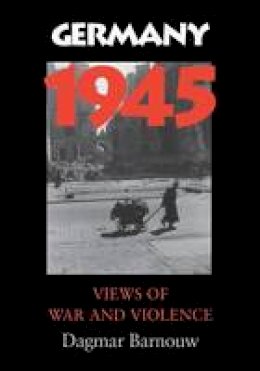
Stock image for illustration purposes only - book cover, edition or condition may vary.
Germany 1945: Views of War and Violence
Dagmar Barnouw
€ 33.55
FREE Delivery in Ireland
Description for Germany 1945: Views of War and Violence
Paperback. Photographers from the US Army's Signal Corps were with the armies that drove back Hitler's troops. Soon photos of death camps and starving POWs shocked the home front, giving ample evidence of Nazi brutality. This work argues that the photographs tell a more complex story and hold many clues for a better understanding of the recent German past. Num Pages: 280 pages, 128 b&w photos. BIC Classification: 1DFG; 3JJH; 3JJP; HBJD; HBLW; HBWQ. Category: (P) Professional & Vocational. Dimension: 6452 x 4522 x 17. Weight in Grams: 495.
Packed with carefully chosen photos of the concentration camps, German exiles, the war-injured, children, and bombed-out cities, this book is a moving reminder of the material and moral devastation left behind by Nazi Germany. -Rudy Koshar, University of Wisconsin-Madison Demonstrates how perspective plays a key role, not only in photography, but in questions of mastering Germany's past as well. [I]nnovative and fascinating. -Robert C. Holub, University of California-Berkeley After half a century, Germany's coming to terms with Nazism remains a subject of debate. This investigation of the photographic record shows that such debates have overlooked the actual conditions in which postwar German memory was first forged. The Allied forces that entered Germany at the close of World War II were looking for remorse and open admissions of guilt from the Germans. Instead, they saw arrogance, servility, and a population thoroughly brainwashed by Nazis. But photos from the period tell a more complex story. In fact, Dagmar Barnouw argues that postwar Allied and German photography holds many possible clues for understanding the recent German past. A significant addition to the scholarship on postwar German culture and political identity, this book makes an important contribution to the current discussion of German memory.
Product Details
Publisher
Indiana University Press
Format
Paperback
Publication date
2008
Condition
New
Weight
494g
Number of Pages
280
Place of Publication
Bloomington, IN, United States
ISBN
9780253220431
SKU
V9780253220431
Shipping Time
Usually ships in 7 to 11 working days
Ref
99-1
About Dagmar Barnouw
D.B. is Professor of German and Comparative Literature, University of Southern California, and author of Weimar Intellectuals and the Threat of Modernity (Indiana University Press, 1988), Visible Spaces: Hannah Arendt and the German-Jewish Experience (1990), Critical Realism: History, Photography, and the Work of Siegfried Kracauer (1994), Germany 1945 Views of War and Violence (Indiana University Press, 1997, Naipaul's Strangers (Indiana University Press, 2003) and other books of cultural criticism.
Reviews for Germany 1945: Views of War and Violence
[Barnouw's] work shows that perspective plays a key role both in photography and in trying to master Germany's past. [F]ascinating.
Library Journal
[Barnouw's] thoughtful analysis of a large assortment of photographs . . . allows Barnouw to look at how and not just what people saw, and to bring that perspective into conversation with the historical debates about the war's end in Germany.
Journal of Contemporary History
Germany 1945 is best seen as a contribution to [the] debate . . . about the uniqueness or otherwise of Nazi crimes, and the related questions of collective responsibility for those crimes, and the need to go on remembering them.
Times Literary Supplement
Germany 1945 contributes a vigorous voice to the expanding chorus of scholars who have called for increased examination of the immediate postwar years. July, 2009
H-NET Reviews Humanities & Social Sciences
Resist the impulse to 'historicize' the Holocaust . . . and you run the danger of sacralizing it. Barnouw's effort to grapple with these dilemmas is provocative, brilliant, and unsettling.
Washington Times
Library Journal
[Barnouw's] thoughtful analysis of a large assortment of photographs . . . allows Barnouw to look at how and not just what people saw, and to bring that perspective into conversation with the historical debates about the war's end in Germany.
Journal of Contemporary History
Germany 1945 is best seen as a contribution to [the] debate . . . about the uniqueness or otherwise of Nazi crimes, and the related questions of collective responsibility for those crimes, and the need to go on remembering them.
Times Literary Supplement
Germany 1945 contributes a vigorous voice to the expanding chorus of scholars who have called for increased examination of the immediate postwar years. July, 2009
H-NET Reviews Humanities & Social Sciences
Resist the impulse to 'historicize' the Holocaust . . . and you run the danger of sacralizing it. Barnouw's effort to grapple with these dilemmas is provocative, brilliant, and unsettling.
Washington Times
